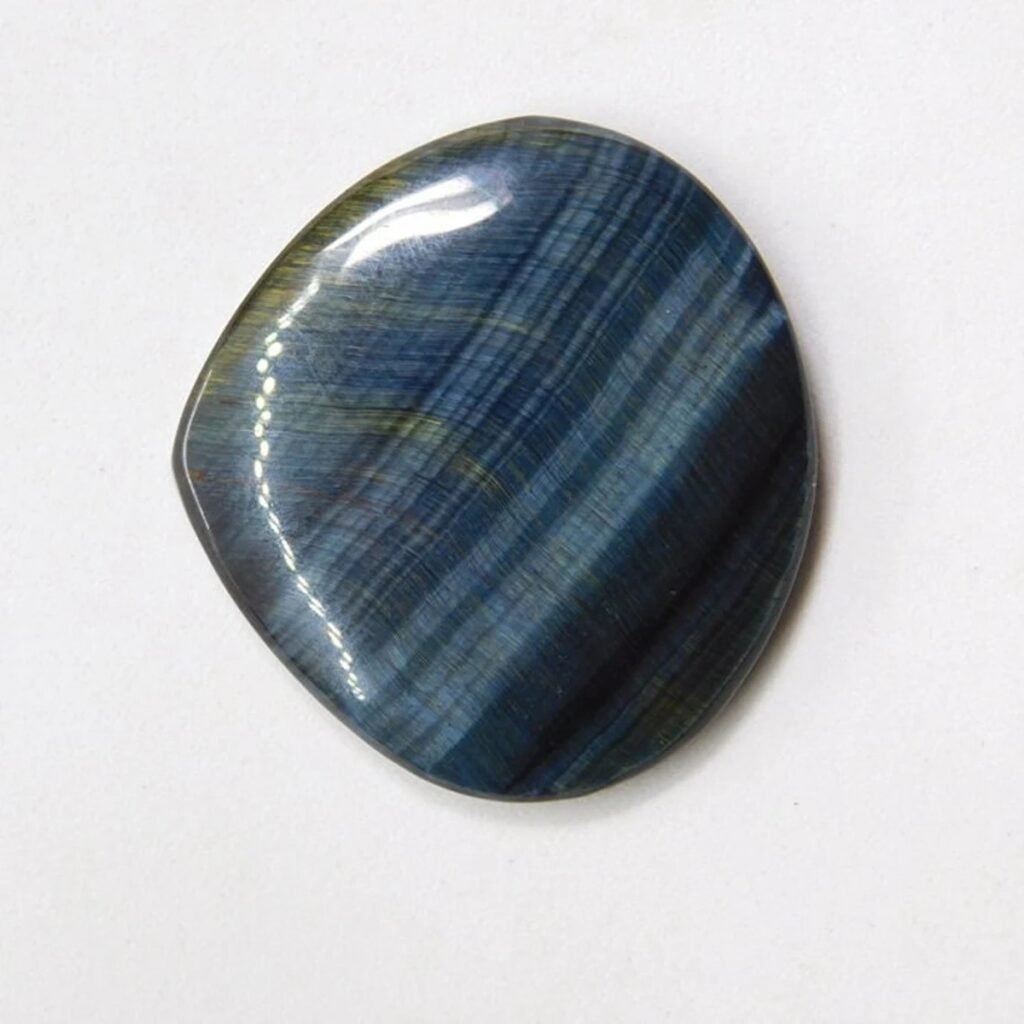The hawk’s eye, blue tiger’s eye, or falcon’s eye refers to an inexpensive, natural bluish-gray chatoyant quartz. A chatoyant gemstone, rock, or mineral is one that displays an optical phenomenon known as chatoyancy or a cat’s eye effect.
Chatoyancy, or the cat’s eye effect, describes an optical phenomenon where some minerals, gemstones, or rocks reflect a movable, concentrated silky streak or band of light when cut en cabochon. This optical phenomenon resembles the eye of a cat, which has a vertical silky slit or streak-like pupils.
This movable, luminous band of reflected light or sheen is caused by a fibrous structure or the presence of tiny parallel, fiber-like, or elongated inclusions that some minerals or gemstones have. These inclusions, empty or filled, include channels, cavities, or tubes.
The fibrous structure or needle-like inclusions reflect light perpendicular to their surface, causing chatoyancy.
The word chatoyancy originates from a French term chat oeil or oeil de chat, meaning the eyes of a cat. This optical phenomenon is named so because it resembles the eyes of a cat.
Besides quartz, other minerals like aquamarine, chrysoberyl, moonstone, alexandrite, tourmaline, sapphire, ruby, and opal, among others, are sometimes chatoyant.

What cause hawk’s eye?
Hawk’s or falcon’s eyes are caused by parallel intergrowths of quartz and blue asbestos or crocidolite fibers. These fibers reflect light perpendicular to their surface, causing the movable, concentrated luminous band of light, or sheen.
Blue asbestos or crocidolite (Na2Fe3Fe2[(OH)Si4O11]2) is a blue-gray, leek-green, or indigo-blue asbestiform sodic riebeckite. Riebeckite is a sodium-rich amphibole belonging to the silicate group.
The blue asbestos can sometimes undergo alteration, forming the golden-yellow, reddish brown, or golden-brown quartz chatoyant gemstones known as tiger’s eye. You can guess that the name suggests this gems resembles the eyes of a tiger.
Properties of falcon’s eye
The hawk’s, falcons, or blue tiger’s eye is a quartz (SiO2) metamorphic rock that contains crocidolite (Na2Fe3Fe2[(OH)Si4O11]2) inclusions. This gemstone has a density of 2.64–2.71 g/cm3, a silky luster, a refractive index of 1.534–1.540, a conchoidal fracture, a brittle tenacity, and a Mohs hardness scale of 6.5-7.
The hawk’s eye color is blue-gray, but it can be dark-blue, navy, blue, and rarely greenish blue. Some specimens may have golden brown streaks or patches if the crocidolite has undergone alterations in some areas.
How is the blue tiger’s eye formed?
The falcon’s, blue tiger’s, or hawk’s eye gemstones form when crocidolite is partially replaced by quartz or through the crack-seal vein filling process.
1. Crocidolite replacement
One of the possible ways that falcon’s eye forms is through the partial replacement of blue asbestos or crocidolite by quartz. This replacement process is pseudomorphous, meaning the replaced mineral retains its initial structure. During this replacement process, quartz replaces crocidolite but retains the nearly parallel asbestiform structure.
The remaining crocidolite is what causes chatoyancy and gives the gemstone a blue, bluish-gray, dark blue, and sometimes green-blue color.
Blue asbestos replacement after alteration to limonite will form the golden-brown, honey, golden-yellow, or reddish-brown gemstone known as tiger’s eye.
2. Crack-seal vein filling
Peter Heaney and Don Fisher proposed the alternative crack-seal vein filling process in their 2003 paper. During their microscopic study of a tiger’s eye gemstone from South Africa, they noticed it didn’t have chalcedony or fibrous quartz.
This observation implied that quartz pseudomorphic replacement of crocidolite was not how the tiger’s eye gemstone formed.
According to Heaney and Fisher, these semi-precious stones form when groundwater that contains quartz and crocidolite enters microcracks found in quartz-rich veins.
The quartz and crocidolite in dissolved groundwater will then grow in these microcracks, filling them. Quartz will begin growing on the microcrack’s surface and will surround the growing crocidolite fibers.
New microcracks will form, and the filling process will repeat itself until you have this gemstone.
Hawk’s eye uses
Some of the uses of falcon’s eye gemstones include making bracelets, earrings, brooches, pendants, rings, and other jewelry.
These gemstones are also used to make pyramids, cabochons, prisms, spheres, or small carvings like intaglios or cameos, and other decorative items.
Imitates or fake blue tiger’s eye stones
There are no fake falcon’s eye gemstones on sale, and the dyed ones are certainly not faux. Dying is a widely accepted practice that does not change the properties of these semi-precious gems.
If you are unsure if the falcon’s eye gemstones you want to buy are fake or genuine, consider their properties like luster, Mohs hardness scale, refractivity index, diaphaneity, and tenacity.
Synthetic chatoyant gemstones like Victoria or Cathay stone, glass, or carbon fiber are easy to identify.
Toxicity
Only liberated or free blue asbestos is harmful, toxic, or dangerous because it causes asbestosis and mesothelioma. The small amount of unliberated blue asbestos in chatoyant hawk’s eye gemstones is, however, harmless. You are at no risk if you wash, or wear jewelry made using these gemstones.
Where do hawk’s eye gemstone originate?
Falcon’s or hawk’s eye is found in the Griqualand area in the Northern Cape province of South Africa and Mt. Brockman and Hamersley in western Australia. Other places with these gemstones are Brazil, China, Namibia, India, Myanmar, the United States, and Sri Lanka.
Frequently asked questions
Dying helps enhance or change the color of these gemstones from the usual blue-gray, blue, or dark blue to more appealing colors like pink, fuchsia, red, purple, rainbow, or green.
Hawk’s eye gems prices range from $0.1 to $3 per carat, depending on color, origin, size, appearance, or rarity. Raw, rough, or uncut will also cost less compared to polished and cut ones.
